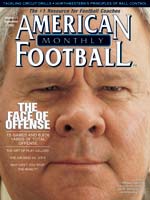AMERICAN FOOTBALL MONTHLY THE #1 RESOURCE FOR FOOTBALL COACHES
Article CategoriesAFM Magazine
|
Get a GripNorthwestern Puts and Emphasis on Ball Securityby: Kevin Johns © More from this issue I have been asked to write about the program that our offensive staff implemented this past season for ‘Ball Security.’ In 2004 we were fortunate enough to go through the entire season (695 touches) with only one offensive lost fumble. This put us first in the Big Ten and tied us for first in the nation. Ball Security is an aspect of our game that our team and coaches take personally and very seriously. We make it a priority at each position to make sure our players understand that fumbles will not be accepted or tolerated. It starts with our head coach, who in 1998 at Miami University coached a team that finished 10-1 and did not lose one fumble! The rest of our offensive staff, Mike Dunbar (Offensive Coordinator), James Patton (Offensive Line), Garrick McGee (Wide Receivers), Jack Glowik (Tight Ends), and Adam Cus....The full article can only be seen by subscribers. Subscribe today!
|
|
|||||||
| HOME |
MAGAZINE |
SUBSCRIBE | ONLINE COLUMNISTS | COACHING VIDEOS |
Copyright 2026, AmericanFootballMonthly.com
All Rights Reserved





